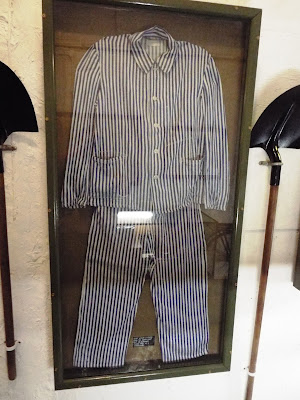During our most recent cruise, Sue and I visited La Valette Underground Military Museum on the outskirts of St Peter Port, Guernsey.
The museum is located in what was intended to be an underground fuel storage facility for U-Boats, but although the fuel tanks were installed, the tunnel complex was never completed. The excavation work was carried out by the Organization Todt using slave labour to do the majority of the heavy manual work.
The tunnels and their contents were left untouched for the first couple of years after the end of the Second World War, but in 1947 two of the three fuel storage tanks were removed. The site was then left untouched again until the early 1980s, when it was proposed to convert the tunnels into a museum. Once approval had been given, considerable work had to be done to ensure the tunnels were structurally safe and that the proposed museum met the current health and safety regulations. This work took two years, and the museum finally opened in August 1988.
As the following photographs show, the museum uses all the available space to tell the story of the German occupation of Guernsey as well as the part played by the people of the Island during the First and Second World Wars.
As will be obvious for these photographs, this is a relatively small museum that is crammed full of exhibits. We were only able to spend forty-five minutes there, but could easily have spent three or four time as long.
The museum is located in what was intended to be an underground fuel storage facility for U-Boats, but although the fuel tanks were installed, the tunnel complex was never completed. The excavation work was carried out by the Organization Todt using slave labour to do the majority of the heavy manual work.
The tunnels and their contents were left untouched for the first couple of years after the end of the Second World War, but in 1947 two of the three fuel storage tanks were removed. The site was then left untouched again until the early 1980s, when it was proposed to convert the tunnels into a museum. Once approval had been given, considerable work had to be done to ensure the tunnels were structurally safe and that the proposed museum met the current health and safety regulations. This work took two years, and the museum finally opened in August 1988.
As the following photographs show, the museum uses all the available space to tell the story of the German occupation of Guernsey as well as the part played by the people of the Island during the First and Second World Wars.
As will be obvious for these photographs, this is a relatively small museum that is crammed full of exhibits. We were only able to spend forty-five minutes there, but could easily have spent three or four time as long.



















































.jpeg)










No comments:
Post a Comment
Thank you for leaving a comment. Please note that any comments that are spam or contain phishing messages or that come from Google Accounts that are 'Unknown' will be deleted.